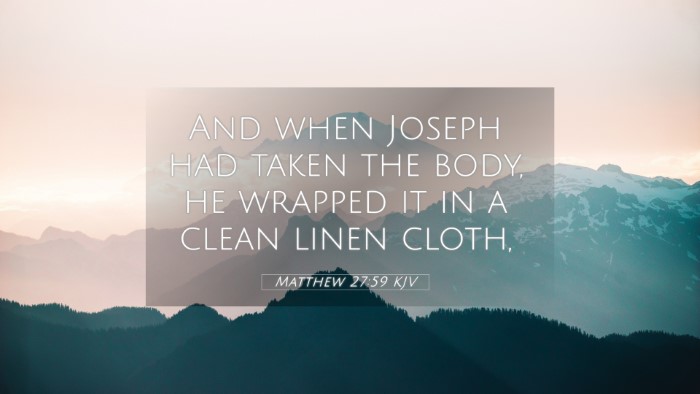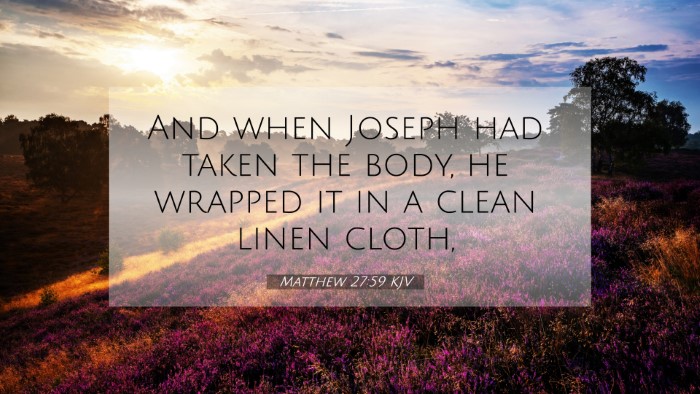Understanding Matthew 27:59
Matthew 27:59 describes the moment of Jesus' burial following His crucifixion. The verse states: "And Joseph took the body, and wrapped it in a clean linen cloth." This act of burial is significant and loaded with theological implications, extending beyond a mere historical event. Through this summary, we will delve into the meaning of this verse, supported by insights from public domain commentaries.
Context of the Verse
This verse falls within the Passion narrative, where Jesus undergoes His suffering and death. The events leading to the burial help us understand the gravity of the sacrifice Jesus made for humanity, fulfilling prophetic scriptures and revealing deep truths of redemption.
Commentary Insights
- Matthew Henry: Henry highlights Joseph of Arimathea's courage and devotion. Joseph, being a secret disciple, publicly claims Jesus' body, showing a shift from fear to boldness. This act not only fulfills the prophecies of Jesus’ burial but also emphasizes the importance of taking a stand for Christ, even in challenging circumstances.
- Albert Barnes: Barnes discusses the use of a "clean linen cloth." This detail signifies purity and respect, contrasting the defilement of the crucifixion. The meticulous care in burial rituals underscores the dignity afforded to Jesus' body, pointing towards His holy nature even in death.
- Adam Clarke: Clarke captures the significance of Jesus' burial as a fulfillment of Isaiah 53:9, which states that the Messiah would be buried with the rich. This connection reinforces the prophetic nature of Christ’s life and death, illustrating the divine plan from the foundation of the world.
Thematic Connections and Cross-References
Matthew 27:59 connects to various themes throughout Scripture, demonstrating the intricate tapestry of the Bible. Here are key cross-references related to this verse:
- Isaiah 53:9: "And he made his grave with the wicked, and with the rich in his death." This aligns with Joseph’s action reflecting both honor and fulfillment of prophecy.
- John 19:38-40: This passage elaborates on Joseph's role and the preparations made for Jesus' burial.
- Mark 15:43-46: Mark records similar details regarding Joseph’s actions, reinforcing the truth of the event across the Gospel accounts.
- Luke 23:50-54: Luke also provides insights into Joseph’s character, describing him as a good and just man.
- Psalm 16:10: "For you will not abandon my soul to Sheol, or let your holy one see corruption." This foreshadows the resurrection, affirming the transition from death to life.
- Acts 13:29: References the fulfillment of the burial as part of God’s redemptive plan through Christ.
- Romans 6:4: Connects the symbolism of burial with baptism, illustrating new life through death.
God's Plan in Burial
The burial of Jesus was not merely a closure to His earthly ministry but a critical component of the salvific work of God. The act of burying Christ serves several functions:
- It signifies the end of the suffering He endured.
- It foreshadows His resurrection, providing hope to believers.
- It emphasizes the reality of Christ’s humanity, having truly died, yet conquered death.
Conclusion
Matthew 27:59 encapsulates profound truths through a seemingly simple act of burial. The insights from various commentaries help to illuminate its theological significance and connections throughout the Bible. Understanding this verse equips believers with a deeper appreciation for the events surrounding Christ's death, the importance of burial customs in the Jewish faith, and ultimately, the promise of resurrection that follows.
Further Study and Cross-Referencing
For those interested in further exploration, tools for Bible cross-referencing can greatly enhance your study. Utilizing a Bible concordance or a Bible cross-reference guide will help facilitate a deeper understanding of connections between verses like Matthew 27:59 and other related scriptures.


